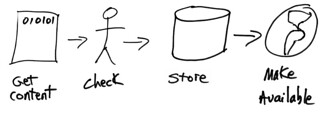
Speaker: Kari Schmidt, American University
Began in 2008 after a new director and consultant group came in and recommended a reorganization. They had some trouble deciding which larger group electronic resource management should be a part of, and ended up on Information Delivery Services, which includes Acquisitions, Cataloging, and Access Services. The ERM unit used to include acquisitions, cataloging, and a service point. By moving the cataloging functions out (and closing the service point), the group could then focus on access and discovery systems (eresource management, licensing). During the same time, they also moved a huge chunk of bound journal volumes to storage to create student spaces.
Focused on moving away from redundancy across different systems, and moving towards cloud-based unified knowledgebases that populated all user interfaces.
Most serials are now electronic, and they are increasingly being tasked to acquire new forms of eresources. Needed to change some workflow models to incorporate ebook acquisitions and management, for example. They are now starting to work more with Acquisitions and Cataloging for those workflows. Large data sets will be the next challenge.
Focusing more on discovery access and assessment, which had been on the back burner. This requires shifting more of the workflow out of the unit.
Training and skill building in ERM techniques include: ERM “class” to orient to role in the library, trouble-shooting access issues, e-resource forums for other tech services staff taught by members of the ERM unit, vendor training sessions, cross-training within the unit, annual evaluation of responsibilities to determine what could be delegated to a specialist (make sure they are interested in it and it is appropriate for them to do), project prioritization, and relevant committee service.
Cataloging has been overwhelmed with legacy print projects, so incorporating ERM work has been challenging. Acquisitions staffing has been disproportionately weighted towards print, so moving more of the ebook process in is a solution and a challenge. Training circ/service point staff to handle basic questions about eresource access issues.
They are using CORAL resources module for tracking ebook workflows.
[Would really like to have a session like this focus on examples more than challenges and things they still need to do. I want to know job descriptions/responsibilities and examples of workflows for different resources.]
Speaker: Christine Korytnyk Dulaney, American University
Staff didn’t talk to each other about work, so they had to make some changes in communication and give them a broader view of the workflow (i.e. how each thing impacted another). They used some project management techniques to begin this process, and it helped them finish the project where they have a history of not doing so. The fundamental concepts of PM can be scaled down to any kind of project. [The presenter goes into this, but you probably have lots of books in your library that covers it.] One advantage of PM is that it focuses on the work and diffuses the emotion that can come from making changes.






